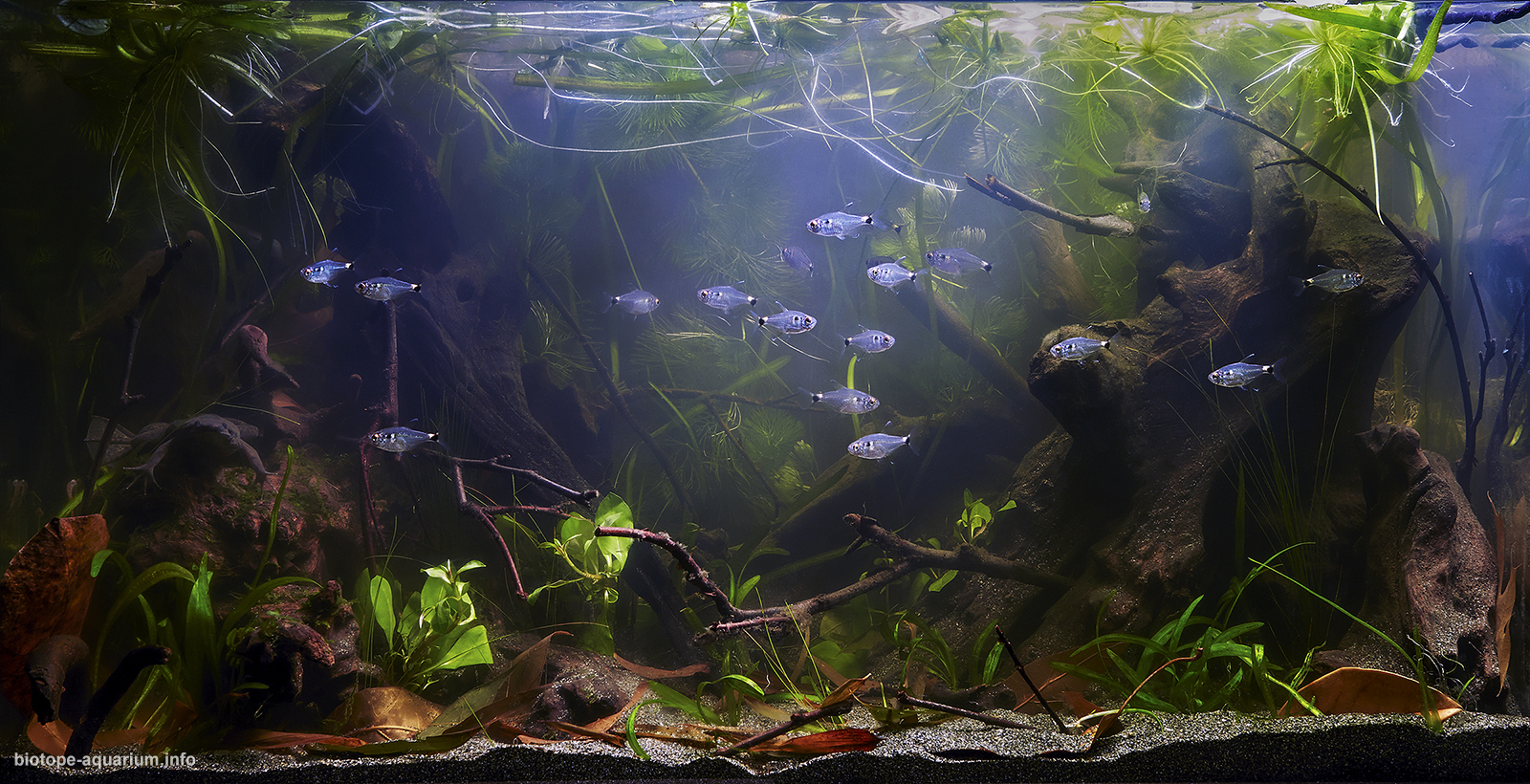Backwater of the Rio Pianco north of Coremas, Paraiba state, Brazil
_st place in Biotope Aquarium Design Contest 2022

There are no images in this gallery.
Volume of aquarium: 70 L
Dimensions of aquarium: 60*30*40 cm
List of fishes: Pipa corvalho, Hemigrammus ocelifer
List of plants: Echinodorus quadricostatus, Vallisneria sp., Eleocharis acicularis, Cabomba caroliniana, Ludwigia sp., Limnobium laevigatum, Pistia stratiotes
Description of Decorations and Substrate:Decotop Borneo driftwood, JBL Sansibar DARK decorative primer, small alder branches, DECOTOP guava leaves.
Description of Equipment: Tetronic LED ProLine 580, AQUAEL Turbo 500
Water Parameters: t 27°C, pH 7, gH 5
Additional Info:The Corvalho pipas presented in the amphibian biotope are of scientific interest from the point of view of their reproduction process.
After fertilization of the eggs, the male presses them with his abdomen into the back of the female, laying them in rows. In total, there are from 50 to 200 eggs in a clutch. A few hours after laying, a gray porous mass forms on the back of the female, in which the eggs are sunk, then molting occurs. Tadpoles at room temperature mature in 2 weeks. The tadpoles emerge from their shell unevenly; at the time of birth they are 1 cm long, have a spherical body and a transparent tail. They feed on bacteria and ciliates. The transformation into a frog occurs two months after birth. After the release of all the tadpoles, the frog molts a second time and is ready to mate again.
Corvalho pipas can be kept with calm fish that are proportionate to it, because in nature they feed mainly on invertebrates, and therefore, with regular feeding, they do not show interest in such a neighborhood.
Aquarium video:
Description of the Area Surrounding the Biotope: The Brazilian river Rio Pianco (450 km) flows in the western part of the state of Paraiba. It is born in the foothills of the mountain range that separates the states of Paraiba, Pernambuco and Ceara, and, after passing through the dam, flows into the Azuda de Coremas reservoir, which supplies water to dozens of municipalities, including the city of Coremas. From there it joins the Piranha Asu system, which is still in Paraiba territory. The Rio Pianco basin covers an area of 5,683 km². Due to its proximity to the equator, the state of Paraiba has a warm climate, with an annual rainfall of less than 800 mm, with high temperatures throughout the year. Like most rivers in the Brazilian semi-arid region, the Rio Pianco is not naturally permanent. During the rainy season, when the water level rises in the river, sparse forests are flooded. In the area where the river flows, north of the city of Koremas, hills and lowlands alternate. Along the coast, in wetlands, there are large accumulations of aquatic plants, near the water – thickets of shrubs and low trees (in the state of Paraiba, representatives of the subfamilies Ajugoideae and Viticoideae (Lamiaceae) are most common).
Description of the Underwater Landscape of the Biotope: The water in shallow swampy backwaters near the wooded shores is not entirely transparent, has a brown-sandy color, the bottom is sandy, silty, covered with snags, branches and leaves. In such pools there is an abundance of aquatic plants.
Description of the Habitat Parameters: t 27-30°C, pH 6-7.
List of Fishes and Invertebrates Occurring in the Nature Biotope: Pipa corvalho, Hemigrammus ocelifer, Anchoviella lepidentostole, Awaous tajasica, Poecilia reticulata.
List of Plants Found in the Nature Biotope: Echinodorus quadricostatus, Vallisneria sp., Eleocharis acicularis, Cabomba caroliniana, Ludwigia sp., Limnobium laevigatum, Pistia stratiotes, Lemna minor, Eichhornia crassipes, Nymphaea sp.
Threats to the Ecology of the Biotope:
1. Human intervention in connection with his agricultural activities contributed to the almost complete disappearance of the tugai forests that once covered the river coast.
2. The Rio Pianco River in the region of the municipality of Pombal receives polluted sewage. According to the results of a microbiological water quality analysis conducted in 2016, a high concentration of E. coli (> 898 to > 1100 UFC 100 ml-1) was found in the waters of the river at all sampling points. The condition of the Rio Pianco, especially in the area bordering the city of Pombal, is extremely critical and exceeds the restrictions of the current Brazilian legislation regarding drinking and bathing conditions, and also poses a threat to the existence of aquatic organisms.
Sources of Information:
- Кассельман К. Атлас аквариумных растений. 200 видов / Пер. с нем. В. В. Домановской. – М.: «Аквариум-Принт», 2009.
- Ганс Й. Майланд. Аквариум и его обитатели / Пер. с нем. М. Жданова, А. Кацура. – Бертельсманн Медиа Москау АО, 1998.
- Пыльцына, Е. Е. Аквариум. Новая современная энциклопедия. – Ростов н /Д: Владис ; М.: РИПОЛ классик, 2011.
- https://silo.tips/download/impactos-ambientais-nas-ma..
- https://books.google.ru/books?id=qhX9DwAAQBAJ&pg=..
- https://www-lareferencia-info.translate.goog/vufind/R..
- https://hasta-pronto.ru/paraiba/
- https://www.fishbase.se/search.php
- https://www.researchgate.net/publication/309769038_So..
- https://amphibiaweb.org/cgi/amphib_query?where-genus=..
- https://www.youtube.com/watch?v=EpO8eOVZMaA
- https://www.youtube.com/watch?v=xu5xHrqK4Ms
